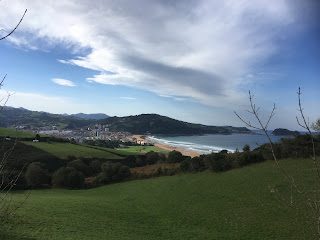Deciding we would almost certainly stay longer with so much to do, and blessed with more sunny weather, we decided to take a circular walk from the site. There is a long distance path (the GR 121) that winds itself along the Cantabrian coast, and we were fortunate enough to be able to complete one of the (shorter!) sub-sections.
Starting from the site we soon left the surf rolling onto the beach at Orio behind and started the slow, and steep climb…
As we climbed higher we were able to see further along the coast as well as appreciate the sets of waves lining up for the surfers back at the beach…
And as we reached the farm and guest house that marked the point of no return/decision to carry on climbing higher, Mr B started enthusing about the fabulous mountain biking opportunities as he spotted numerous tyre tracks in the mud…
Nearing the highest part of this route, from which look-outs used to watch for whales and signal back with flags to the rowing boat crews on the beach (Orio has the dubious distinction of sending a crew to kill the last Right whale caught on this part of the coast) we opted instead for a sighting of the ever present AP8 motorway, which spans the river at Orio and provides an audible reminder of the march of the motor car…
It’s not that bad really, as the noise is easy to filter out – which is just as well as it’s also visible from our campsite!
Descending towards the town of Orio we discovered that not only were we completing a section of the GR121, but also the Camino de Santiago de Compostela… or one of them.
There are many sections of the famous Camino, all of them designed to make the passage of pilgrims easier, with numerous places to rest, and had we been minded, we passed a chapel and a hostel on our way back into Orio…
Winding our way back down to the riverside in the town, its close connections to the sea and fishing could be seen in the ocean going trawlers in the harbour…
as well as the artistic influence on some of the buildings…
With darkness falling and a kilometre left to get us back to the campsite, we loved the bustle and chatter of the locals in the very busy cafes and bars on our route. There’s a real sense of community here it seems; with most of the housing in apartments, the locals are clearly making the most of the ability to meet and chat as day turns to night.
After our amazing day out in Donostia/San Sebastián (see previous entry) we couldn’t help but try walking in the other direction to the western town of Zarautz, another surf destination.
This time, we’d get the train back, having loved the efficiency and great value of the Euskotren to the city and also having done a lot of steps in the past two days!
As we walked through the site, we were struck by how busy it had become, with loads of Spanish campers arriving for the last weekend of the season!
We climbed up the slopes on the opposite side of the river to our previous walk, and found ourselves amongst the vineyards of the local Txakoli wine that we had loved in Donostia/San Sebastián the day before. Quite a novel experience to have discovered a wine we had never heard of, enjoyed it, only then to be wandering through the landscape it had been grown and made in!
The vineyards are small in comparison to those we have seen in France and even the UK, and the tradition seems to be lots of small producers, with even smaller sub-denominations across the slopes…
Pausing to take a breather outside one of the local producers…
…and spotting yet another Camino sign, slightly more interesting than the last one…
…we found ourselves outside the other ACSI site that we nearly chose to come to, Camping Zarautz. Perched on the top of the hill we had just climbed, it had fabulous views across to the town we were heading to…
But was literally in the middle of nowhere – great for a few get-away-from-it-all days perhaps, but not exactly an easy walk to get the train, or shop, or much else except enjoy the 440 steps down to the beach, and back up…
…passing the abandoned iron ore loading jetty…
…and the golf course (founded in 1908) sandwiched between the river and the sea…
arriving eventually at the beach…
…where we enjoyed a lush €17 menu del dia, whilst watching the surfers catch the waves rolling in as we chilled and enjoyed a seafood delight…
Waving goodbye to the beach at Zarautz after a very leisurely lunch…
we caught the train back to Orio, to finish off the walk, as we still had the last leg to complete!
As we crossed the bridge to get back over the river, we were lucky to see one of the local rowing teams practising…
Based on the old sea-going rowing boats used for whaling, nowadays these boats are adapted for competitions between the trawler crews, family and friends.
Arriving back at the site just in time to see the sun setting over the hills opposite our pitch, we agreed to treat ourselves to a day off for our last day in Orio, and indeed Spain, as we prepared to cross the border with France.
We have had an amazing time here in Eusakadi the last few days, and in Spain generally the last seven weeks or so – with weather that may say more about global warming that we will ever know, we have been very fortunate indeed.
¡Gracias España!
S&J
xxx





























































